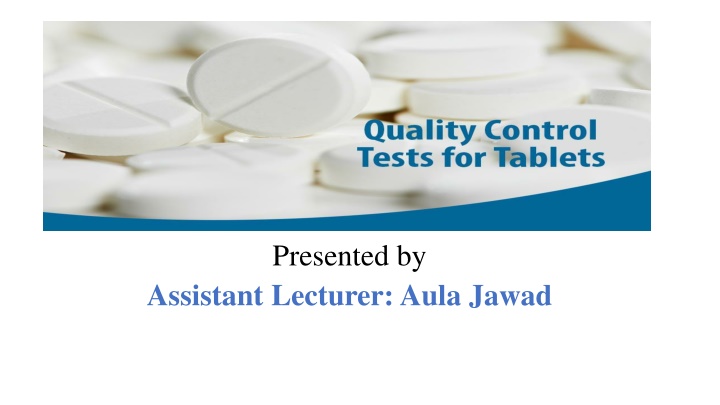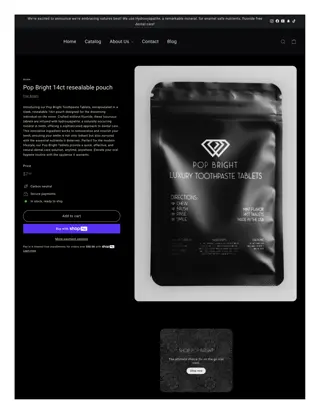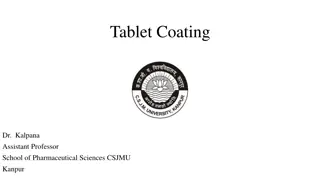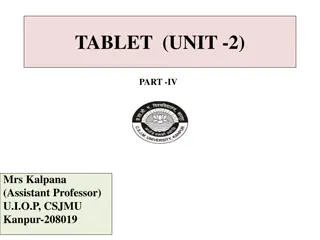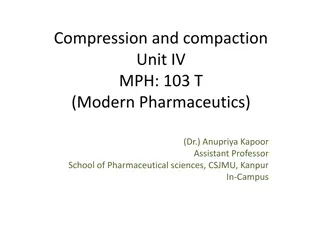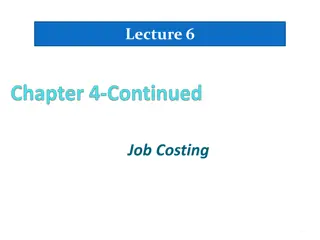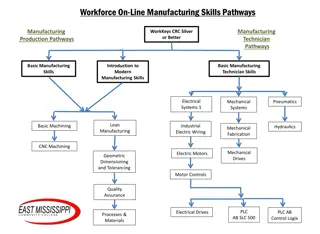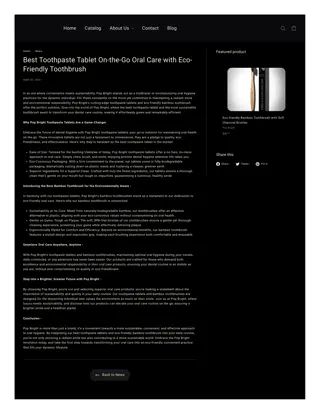Quality Control in Tablet Manufacturing: Ensuring Product Excellence
Quality control in tablet manufacturing is essential to ensure that each tablet meets the required standards. The Quality Control (QC) department plays a crucial role in sampling, testing, and documentation throughout the manufacturing process. Various tests, such as weight variation, disintegration, and hardness, are conducted to maintain product quality. Factors like general appearance, organoleptic properties, color uniformity, and tablet thickness are thoroughly evaluated to ensure consistent quality and consumer acceptance.
Download Presentation

Please find below an Image/Link to download the presentation.
The content on the website is provided AS IS for your information and personal use only. It may not be sold, licensed, or shared on other websites without obtaining consent from the author.If you encounter any issues during the download, it is possible that the publisher has removed the file from their server.
You are allowed to download the files provided on this website for personal or commercial use, subject to the condition that they are used lawfully. All files are the property of their respective owners.
The content on the website is provided AS IS for your information and personal use only. It may not be sold, licensed, or shared on other websites without obtaining consent from the author.
E N D
Presentation Transcript
Presented by Assistant Lecturer: Aula Jawad
Evaluation of tablets done by quality control (QC) department Role of Q.C. department (a small part of quality assurance QA-): concerned with sampling, testing, and documentation during and after completion of the manufacturer. Q.C.: a set of steps taken during the manufacturing to ensure that the product meets the requirements and is reproducible. It also monitors the product after manufacture and comparing it with standards to find out the causes of deviation from standards thus ensuring the quality product not once but every time.
Quality control tests Official tests Weight variation Content uniformity Disintegration test Dissolution Non-official test friability Hardness Thickness General Appearance a- Shape and diameter b- thickness
1. General appearance: The tablet should be elegant The control of general appearance involves the measurement of attributes such as: The size and shape of tablet, Organoleptic properties (color, presence or absence of odor, taste, surface texture and consistency ) A. The size and shape The diameter and shape are a function of( depends upon) the die and punches. tablets are discoid in shape, oval, oblong, round, cylindrical, or triangular. The upper and lower surfaces may be concave and/ or tagged with a logo. The tablets might have a grove to facilitate breakage into smaller doses.
B. Organoleptic properties: The colour( the tablet should be uniform in colour from tablet to tablet and from batch to batch) Color (rapid identification and consumer acceptance). Non-uniformity in colour is called .?? Non-uniformity in colour could be associated with: Non-uniformity in content poor product quality The odour : 1. important for consumer acceptance 2. identification of drugs(; e.g., vitamins) 3. detection of a stability problem (e.g., ASA etc.) The taste: is of particular importance for ??? .. tablet
Thickness The thickness depends upon the compression process and die fill: Tablet thickness is evaluated to assess the tablet-to-tablet uniformity and quality of our product. The thickness is uniform if: Consistent compression force. Consistent particle size ( uniform and same form batch to batch) may affect packing of powder during compression Consistency filling process ( good followability); otherwise it causes variation of weight from tablet to tablet Tablet thickness should be controlled within a 5% variation of standard value.
MEASUREMENT OF THICKNESS Micrometer: measurement, provide information on variation between tab.). measure individual tabs. thickness (so accurate Holding tray: measure total tab. thickness (5-10 tab). not an accurate information provider on variation between tabs but overall estimation give more rapid readings.
Hardness Test (Non-Official) A tablet should possess some degree of mechanical strength to withstand the mechanical shocks caused by handling during manufacturing, packaging, shipping, and dispensing. Tablet hardness: (tablet crushing strength) force required to break a tablet in a diametric compression test. Hardness test: a tablet is placed between anvils, and the crushing strength that just causes the tablet to break is recorded. Tablet hardness can affect disintegration how???
Factors affecting hardness Die fill ? Compression force? Quantity and quality of binder? Lubricant can affect tab hardness (if too high conc. or long time mixing)? The method of tableting? Tablet diameter?
Methods of hardness measurement Monsanto hardness tester (manual) Pfizer tester (simple, low cost, and rapid) Erweka tester (electrical) Schillinger tester (electrical) widely used because it s fast and reproducible-. The unit of hardness is expressed in kg
How to measure the hardness??? i. Measure the hardness of individual 3 tablets and take the average. ii. Put the tablet vertically between the jaws of the machine and increase the load until the tablet has been cracked. iii. Record the hardness at this point and calculate the average. tablet hardness within 4-10kg (1Kg=10 newton) for normal tablet 3kg for chewable tablets: 10-20Kg for coated tablets
Friability Test It measures the tendency of tablets to powder, chip, and fragment This results in: Lack of elegance and consumer acceptance. Create an excessively dirty process in areas of manufacturing such as coating and packaging. Tab s weight variation or content uniformity problems The machine is called friabilator or friability tester (Roche friabiliator) Factors affect friability??
How can measure tablet friability?? 1. Weigh 20 tablets together (W0) 2. Put these 20 tablets in the friabilator and set the machine to run at 100 rpm for 4 minutes (i.e.,25 rpm). 3. Remove any loose dust from the tablets before weight 4. Weight the 20 tablets ( only the intact one)=W1 5. Calculate the friability(% of loss)=W0-W1 ?0 100 6. The accepted value =<1%. (however if it is more, do not reject the batch as it is a non-official test) vi. If cracking, chipping, or fragmentation of the tablets is observed, should not be considered for commercial use regardless of the value of % loss.
DISINTEGRATION TEST The disintegration test measures the time that is required for a tablet to break up into small particles at certain conditions ( temp, media). Disintegration test is indicated for all tablets except : Chewable tablets, Those tablets should dissolve slowly such as lozenges, glycerine trinitrate some types of sustained-release products Factors affecting disintegration of tablet??.
Disintegration conditions medium Water. HCl pH=1.2 simulated gastric juice. Simulated intestinal fluid (pH=7.4). Temp=37C.
Method Place one tablet in each of the six tubes of the basket (tablets are selected randomly). Position the basket rack in 1- L beaker containing distilled water (as the disintegration medium) maintained at 37 Start the apparatus (to move the basket assembly containing the tablets), and record the time required for all of the six tablets to break into particles and to pass to the disintegration medium.
According to the USP Uncoated tablets disintegrate within 5-30 min. Enteric-coated tablets are to show no evidence of disintegration after 1 hour in simulated gastric fluid. These tablets are then tested in simulated intestinal fluid and are to disintegrate in 2 hours. Limit: The tablets should disintegrate within 30 minutes (uncoated tablets). If one tablet fails to disintegrate within 30 minutes, the disintegration test is repeated on 12 additional tablets. Not less than 16 out of the total 18 tablets tested disintegrate completely within 30 minutes
Weight variation test weight of the tablet being made is routinely measured to help ensure that a tablet contains the proper amount of the drug. The amount of material in the die determines the weight of the tablets. Factors affecting wt. variation: Segregation of the powder Poor flow Poor mixing Variation in the adjustment of the upper and lower punch Use of insufficient quantity of lubricant
Method a. Weigh 20 tablets individually and calculate the average mass. b. The deviation of individual masses of each tablet from the average mass should not exceed the limits given below Limit: According USP,
1. If 1 tablet is out of the range, but less than double the allowed%(pass) 2. If 2 tablets are out of the range but less than double the allowed %(pass) 3. If 3 tablets deviate more than the allowed range % (failed). 4. If only one deviates more than the double allowed limit (failed) NOTE Wt. variation method used to determine drug content uniformity, if powder of tab. contain 90-95% active ingredient, while wt. variation test is not sufficient to assure potency uniformity for moderate to low-dose drugs in which excipients make up the bulk of the tab.
Content uniformity test Factors that may cause variation in content uniformity of tablets: Insufficient mixing (Non-uniform distribution). Segregation. Bad flowability Packing of powder which might result in variant particle size. Variations in content uniformity cause more problems in low-dose drugs than in high-dose drugs.
measurement of content uniformity of paracetamol spectrophotometrically 1. Select randomly a 10 tablets-sample, then examine each tablet individually, grind it and transfer an equivalent weight of 100 mg of active ingredient into 100 ml volumetric flask. 2. Dissolve in 100ml (0.1M) NaOH and sonicate for 5 minutes. 3. Filter the resultant solution. 4. Dilute 1 ml of filtrate up to 100 ml with water. 5. Measure the absorbance of the resulting solution at 257 nm, using 0.001 M Sodium Hydroxide as blank. 6. Use the calibration curve to calculate the recovered concentration of paracetamol.
Dissolution test This test determines the amount of active ingredient(s) released from a solid oral dosage form, such as a tablet or a capsule, under controlled conditions using a known volume of dissolution medium within a predetermined length of time.
The formulation and manufacturing factors that affect the dissolution of a tablet Particle size of the drug The solubility and hygroscopicity of the formulation The type and concentration of excipients such as binder, disintegrant and lubricant used The manufacturing method especially the compactness of the granulation, the compression force, granulation, mixing, and coating
